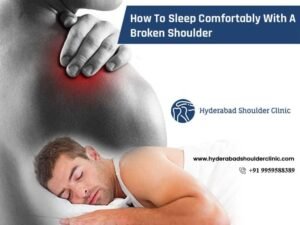Regarding mobility, the shoulder joint is one of the most mobile joints in the body. It can rotate in many directions, but this same advantage makes the shoulder easy to dislocate. A dislocated shoulder means the head of your humerus (the ball-shaped upper arm bone) moves out of the shoulder joint or the socket. The shoulder joint is the most commonly dislocated joint in your body. The shoulder joint may fall out of alignment when a significant force is applied to your shoulder joint.
A shoulder joint can be dislocated either partially or completely, called partial shoulder dislocation and total shoulder dislocation, respectively.
The humerus bone (arm bone) has a round head at the top, and it fits exactly into the scapula (shoulder bone), which is called the “glenoid fossa.”
In partial shoulder dislocation, the humerus head doesn’t come out of the socket completely. These partial dislocations are often called subluxations, and anyone can have them. Fortunately, these conditions are not uncommon, and the treatment is also simple.

In the case of a complete shoulder dislocation, the head of the arm bone (the humerus) is displaced completely out of its place (the socket) and requires immediate medical attention. Therefore, one should not try to push the bone back into the scapula when it happens.
What Causes a Partial Shoulder Dislocation?
Shoulder dislocations most commonly occur due to:
- seizures or strokes
- traumatic incident
- in response to an injury, such as sports injuries.
- Falling on your shoulder or outstretched arm.
Strokes can result in muscle contractions, which weaken your muscles and ligaments. The shoulder joint becomes more vulnerable to partial shoulder dislocation when this weakening occurs. Anyone planning to engage in physical activity after a stroke should be more careful because they are more susceptible to dislocations.
Trauma can lead to dislocations in a way that no other scenario can. An injury to the shoulder is one of the most common causes of dislocation. These injuries are often caused by an intense force hitting the body, such as vehicle accidents, sporting-related accidents, or even falling from heights in the home or workplace. In addition, existing injuries can increase the chances of a partial shoulder dislocation.
How Do I Know That I Have a Partially Dislocated Shoulder?
Most of the time, the symptoms of a partial dislocation are the same as those of other shoulder dislocation types. If you suffer from a partial shoulder dislocation, you will experience mild to severe pain in your shoulder joint and surrounding areas. The range of motion will be reduced, and you may find it painful or unable to do your everyday tasks.

It’s also very common to see a visible deformity in your shoulder shape, which is a strong sign that something is wrong with your shoulder joint.
Pain is a common symptom when an individual has a dislocation, but some people may experience a numb feeling and experience weakness in the muscles around the shoulder. Other signs that indicate a dislocation are swelling and bruising, which may appear based on the cause of the injury.
Treatment for Partial Shoulder Dislocations
The primary aim of the treatment is to reposition the dislocated shoulder joint and make sure it stabilizes.
To diagnose a dislocation, doctors usually perform a physical examination and also take an x-ray. It will help the doctor determine the nature of the dislocated joint and visualize the injury’s extent.
An ultrasound may also be performed because diagnosis is the key to administering the best course of treatment.
The following are the treatment options:
Closed reduction: The doctor manipulates the bone gently back into place using closed reduction techniques. This may result in almost immediate pain relief.
Surgery: This is commonly suggested when dislocations recur. But when a partial shoulder dislocation is associated with damage to nerves, blood vessels, or ligaments around the joint, surgery is recommended.
Shoulder brace: Wearing a shoulder brace, splint, or sling is suggested for a few days to prevent unnecessary shoulder movement. Depending on the severity of the dislocation, the length of time may vary.

Medication: To manage post-operative pain and inflammation, pain relievers, muscle relaxants, and anti-inflammatory medications are suggested by doctors.
Rehabilitation: Rehab following the surgery is crucial to recovering safely and quickly. An effective rehabilitation program will help you regain many shoulder functions, like the range of motion, strength, and stability.
Can Partial Shoulder Dislocation Become Recurrent?
A shoulder dislocation can, unfortunately, occur again after treatment due to the relatively unstable nature of the shoulder joint. For example, suppose your dislocated shoulder joint is not correctly positioned, and you have not practiced the preventive measures. In that case, it is all too probable that joint instability, along with a preexisting injury, may result in a recurrence of the dislocation.
Physical therapists and chiropractors have the experience and skill set to maintain your shoulder joint health without compromising its flexibility.
For more information about partial shoulder dislocation treatment in Hyderabad, consult Dr Chandra Sekhar, one of the best doctors who can fix partial shoulder dislocation. Call 9959588389 to book a consultation with the doctor.





